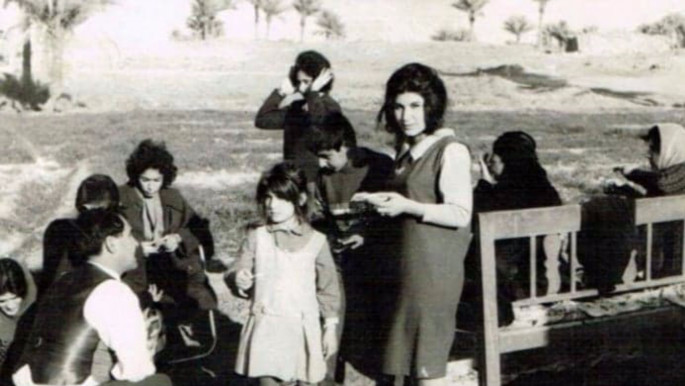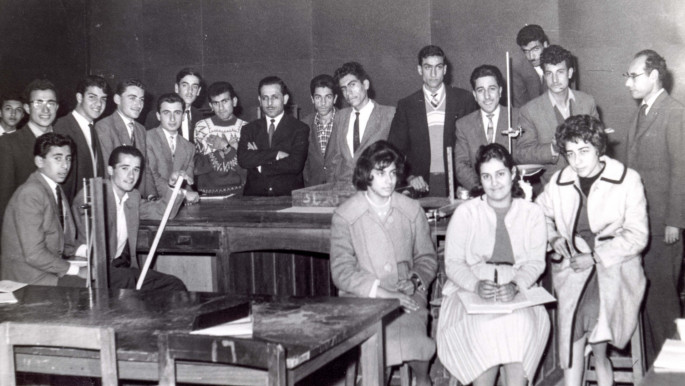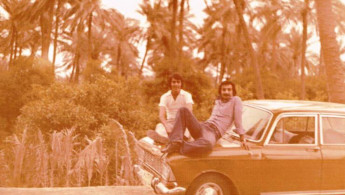Tracing a lost past: National memory in the forgotten photo archives of Iraq
Far removed from today's landscape of military fatigues and rubbled cities, the photographs displayed exude ordinariness, joy and national progress.
Tiles of photographs - black and white, sepia, and faded shots - form the landing page of the project's website, conceived by Irish-Iraqi visual artist Basil Al-Rawi as part of his doctoral degree at the School of Simulation and Visualisation at the Glasgow School of Art.
National memory, photography and oral history are the key components that the IPA plugs into.
Stirred by the visual landscape of the Iraq that his father inhabited and recorded photographically in the 1960s - and the itch to connect - a curious Al-Rawi spent his youth hunting for images of Iraq.
Early on, it was plain to see that the best preserved were part and parcel of colonial exploration under British-occupied Mesopotamia.
 |
Iconic date palms, impish smiles, summer breaks, weddings, and people dancing, laughing and graduating are just some of the scenes of Iraq's lost past as catalogued by the Iraq Photo Archive |  |
In subsequent decades, Iraq, according to Al-Rawi, became a "place of conflict," in which war photography was the front and centre of news coverage.
The 39-year-old artist stressed the gulf that separated the Iraq his father documented and the "visual coverage of Iraq that was primarily of conflict" from the perspective of an Irish-raised Iraqi. Yet behind this, he saw an equally valuable visual landscape lying dormant.
 |
|
| Family picnic with the aunts and uncles, you can see pots of food and bread held by my grandmother. [IPA] |
The IPA reveals the Iraq captured by its people, previously unseen, as though removing a shroud behind which a golden obelisk stands.
After a leave of absence following the passing of Al-Rawi's father, the digital project resumed life. "Of course, I'm coming into it from my own frame of reference as an Iraqi who grew up in Ireland," Al-Rawi told The New Arab, explaining the project's focus on the diaspora in the UK, Ireland and Europe.
 |
Far removed from today's landscape of military fatigues and rubbled cities, the photographs displayed exude ordinariness, joy and national progress |  |
Al-Rawi began by launching an online portal where the "photos that Iraqis have in their own photo albums" can be submitted "anonymously", Al-Rawi said, in line with the project's ethical guidelines. He then created an Instagram account that has been active since February 2020.
Outreach and promotion, which Al-Rawi described as the "the hardest part", came next. In an effort to encourage submissions Al-Rawi found in Iraq's second generation an ally, "kindred spirits" that would "track and submit" their family portraiture and disseminate word of the project.
| Instagram Post |
Before Covid-19 ground life to a halt, Al-Rawi had hoped to organise a "scanning session" in London, home to Europe's largest Iraqi diaspora community, to introduce people to the initiative.
As scanner ownership and use diminish in an age of technological takeover, fewer people have access. Google photo scan, though not quite a machine, is an app designed to scan physical photographs that can be saved to the device of capture as a useful (contactless) alternative, Al-Rawi said.
As viewers browse through the IPA's burgeoning collection, they fall prey to the spell of the image - each flaunting its own unreplicable moment and identity.
As a challenge to the growing trend of photo dumping on social media platforms and private channels, the archive offers an alternative of a "nicely designed place where people can look at them" Rawi said. "Photos are largely formal and informal, some reflect the times they were taken during".
An archive of images that collectively speak of a past untouched by war, is so achingly necessary for a country pillaged not only for its mineable resources but its historical memory too. "The history of modern Iraq has been just that," Al-Rawi said, "people trying to control every kind of resource".
While the media is known for its disfiguration of public discourse in relation to the invasion of Iraq, few discuss war as the disfiguration of historical memory.
"I'm a visual artist and my approach is not that of a curatorial archivist," Al-Rawi said. The archive is in fact the first of three other phases. "I'm not creating the archive" Al-Rawi stresses, "it's created by the people who connect with it - I just created the space".
Post-submission, participants are invited to discuss the photographic moment and what is not represented by the image — scents, sounds, the rural or architectural landscape, those off-camera, and even how the subject may have felt that day.
Conversations will be recorded in an effort to "recreate the moment in an immersive virtual reality experience," Al-Rawi told The New Arab.
Enabled by the possibility of recovery, the project's methodology is described as a "crossover between photo as a means of storytelling and oral history as a means of hearing directly from the people in the photographs," Al-Rawi said.
 |
The photos tell Iraq's history from the bottom-up, chronicling Iraqi lives, among them the occasional cultural giant as well as the prized family members people loved and lost |  |
The third phase of the project calls attention to the intangible, centred around a virtual space Al-Rawi hopes to build to resurrect Iraqi stories and allows the public to engage with them.
He envisages building inside of this virtual space a 3D model of Iraq's revered Shanasheel houses, vernacular architecture at risk of disappearing due to architectural neglect and rampant corruption in the new Iraq.
"People step into the virtual space, see a photograph, pick it up to be teleported back to the lived memories" animated by the photographs collected during phase one, Al-Rawi said.
 |
|
| My father with his classmates at the University of Baghdad. [IPA] |
If photo albums are a site of memory as Al-Rawi theorises, then the intended virtual space acts as a surrogate for those memories, for people to roam and explore. Al-Rawi likens it to the magic of cinema through which spectators can relive the past.
Altogether, these phases tell Iraq's history from the bottom-up, chronicling Iraqi lives, among them the occasional cultural giant as well as the prized family members people loved and lost.
The resulting visual narrative delivers a compilation of oral histories, reinforced by a unique archive of photographs and "memory simulations" that Al-Rawi promises will be exhibited once the project concludes in 2021.
Nazli Tarzi is a freelance British-Iraqi journalist, specialising in Middle East politics, with a particular interest in Iraqi affairs.
Follow her on Twitter: @NazliTarzi


![President Pezeshkian has denounced Israel's attacks on Lebanon [Getty]](/sites/default/files/styles/image_684x385/public/2173482924.jpeg?h=a5f2f23a&itok=q3evVtko)



 Follow the Middle East's top stories in English at The New Arab on Google News
Follow the Middle East's top stories in English at The New Arab on Google News


